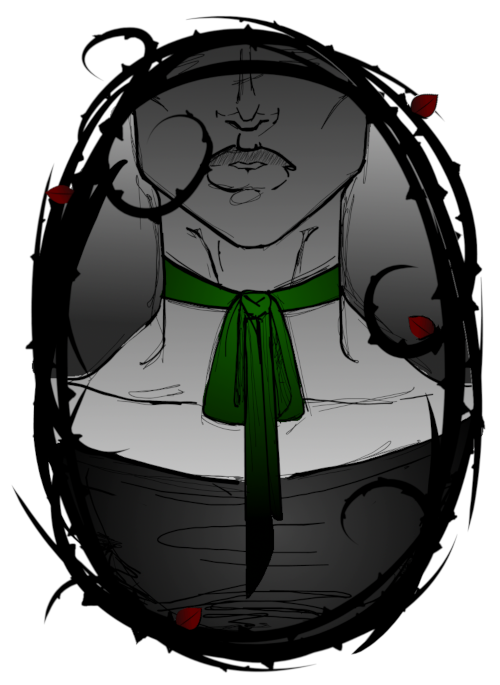For two years now, Sirens has published an ongoing series of essays that showcase the brilliance of our community—and give those considering attending a look at the sorts of topics, perspectives, and work that they are likely to encounter at Sirens. While we’ve postponed our in-person program to 2021, and we are gathering safely online this weekend, we wanted to take this opportunity to feature the exemplary work that the Sirens essayists have presented over the past two years. We hope that you find these works thoughtful, bold, and brilliant.

A Wife Should Have No Secrets: Unthinking Privilege and Privacy in Carmen Maria Machado’s “The Husband Stitch”
by Faye Bi
If you prefer, we offer a video of Faye reading this essay:
Carmen Maria Machado’s short story “The Husband Stitch” published online in 2014 and is the first story in her acclaimed short fiction collection, Her Body and Other Parties. It’s the story of a woman with a green ribbon around her neck, who meets a boy who becomes her husband, and with whom she raises a son. Before I continue, Machado’s fairytale focuses on a cis-het relationship, so I will be using that language in my analysis. As a reader, I acknowledge the pervasive and structural nature of toxic masculinity. Male privilege affects queer, nonbinary and transgender people in ways that are similar, but often more violent.
Upon their first meeting, the boy asks the narrator if he can touch her ribbon. She says no. “There are two rules,” the narrator shares, “he cannot finish inside of me, and he cannot touch my green ribbon.” The ribbon represents a few things: her voice, given its placement around her throat; a piece of herself more sacred than her body, which she gives to her husband freely; and, with the introduction of other women with ribbons, an essential part of their identity women choose to keep for themselves and not to share with men, even their husbands and sons.
With “The Husband Stitch,” Machado has woven folklore, storytelling, and women’s pain and experiences—and men’s attempts to violate or invalidate them—in a social horror that too successfully captures the current zeitgeist in an era of #MeToo and #NotAllMen.
First, the green ribbon in “The Husband Stitch” is a reference to a European folk motif in which a red thread is worn around a person’s neck, which marks the place where their head was severed and then reattached. The most popular iteration of this motif—one that Machado may have borrowed from—is “The Girl with the Green Ribbon” in Alvin Schwartz’s 1985 children’s story collection In a Dark, Dark Room. There, too, a man (named Alfred) meets a woman (named Jenny) with a green ribbon around her neck, who agrees to marry him on the condition that he never touches it. Years later when Jenny is on her deathbed, she unties her ribbon and her head rolls off. The common adult response to this story from a cursory internet search is a) that it messed them up as a child, b) shock that it was published for children as young as four, and c) that Alfred had clearly been duped. Jenny was an “undead liar,” and Alfred should have pulled off Jenny’s ribbon far earlier!
Machado, of course, gives no fucks about Alfred. In “The Husband Stitch,” she reimagines “Girl with the Green Ribbon” solely from the girl’s point of view, our narrator. Given the strategic placement of the ribbon around her neck, it symbolizes her voice—and thus, her stories, perspective, truth, and literal speech. In the parenthetical introduction to the story itself, Machado’s narrator sets us up to read the story aloud, determining the voices to use for each character: for the boy who will become her husband, “robust with his own good fortune,” and for her father, “like your father, or the man you wish was your father.” For herself, the narrator tells us: “high-pitched, forgettable” and for all other women, “interchangeable with [her] own.”
We can deduce, then, that the narrator’s stories reflect a universality of themes women will recognize in their relationships.
Our narrator tells us then, how she meets a boy who both her parents are “extremely fond” of, and who they believe will be a good man. She tells us, too, that she and her boy have a lot of very intense, very consensual, very passionate sex throughout their courtship and their marriage, just in case anyone would try to read her boundary setting of not touching her green ribbon as withholding sex. By nearly all accounts, the narrator’s husband can be read as loving: faithful, polite to her family, a hardworking employee, an excited expectant father, and a supportive co-parent. Machado, in establishing a character who will eventually stand as a villain, has not depicted the narrator’s husband as a one-note misogynistic asshole. He has honorable qualities and these descriptions make him all the more recognizable as the dependable male family members in our lives: our husbands, fathers, brothers, uncles, and sons.
At the same time, the narrator’s husband’s words of love, romance, and family can equally be interpreted as ominous, persistent, and violating.
He asks her worst secret, and she confides in him the pain of her molestation by a teacher. The day he proposes, he tells her, “I feel like I know so many parts of you…And now, I will know all of them.” When she tells him she is pregnant, he is thrilled, but asks in the next breath, “Will the child have a ribbon?” Perhaps the most disturbing is the joke he makes with the male doctor after our narrator gives birth: “You offer that extra stitch, right?” He is of course referring to “the husband stitch,” when a doctor sews up a woman’s uterus after childbirth to make sex pleasurable for her husband. Doctors (a profession long dominated by men after midwives lost influence) have denied that the husband stitch exists, and to this day it remains a procedure of speculation… but wouldn’t we ask women who have lived these experiences?
Yet, the passage that’s most illustrative of these violations, and the most enraging, is when the narrator’s husband touches her ribbon without her consent. She has lots of sex—consensual sex!—with him in many, many places: on park benches, in the woods, mere moments before they walk down the aisle to get married, in train cars. But she is most upset and most vulnerable the times he touches her ribbon. When he tries to untie it in a bout of lovemaking, she feels so violated and stops immediately. He tells her:
– A wife, he says, should have no secrets from her husband.
– I don’t have any secrets, I tell him.
– The ribbon.
– The ribbon is not a secret, it’s just mine.
– Were you born with it? Why your throat? Why is it green?
I do not answer.
He is silent for a long minute. Then,
– A wife should have no secrets.
My nose grows hot. I do not want to cry.
– I have given you everything you have ever asked for, I say. Am I not allowed this one thing?
– I want to know.
– You think you want to know, I say, but you do not.
– Why do you want to hide it from me?
– I am not hiding it. It is not yours.
Her simple request and his dogged persistence here only magnifies the pervasiveness of his male privilege and entitlement. She has no secret about the ribbon, and answers none of his questions. But he sees this visible reminder of something to which he believes he has a right. That he has a right to what he believes is a secret, because he does not have access to it, nor can he claim ownership of it—and by extension, of her.
For the narrator, the ribbon is more than just a physical object; Machado suggests it’s sacred to femininity and more private even than parts of her body, even her uterus. This small piece of herself is essential to her identity.
The relationship between the narrator and her son changes, too, around the ribbon. When he is a baby, her son treats and touches her ribbon “no differently than he would an ear or finger.” But as he ages, more layers build between mother and son. When he tries to pull at it, she rebuffs him and shakes a can of pennies. Machado lets us know this moment is the same as shaking a can of pennies and startling the person next to you. “Observe their expression of startled fear, and then betrayal. Notice how they never look at you in exactly the same way for the rest of your days.” And finally, when he is old enough to ask point blank about it directly, she must refuse. “I tell him that we are all different, and sometimes you should not ask questions. I assure him that he’ll understand when he is grown.” And like the narrator’s husband, Machado does not depict her son as categorically bad or even ignorant, but as a kind, gentle soul, who fights bullies and waits to walk with a neighbor boy who is slower than the others. It’s that he must be taught boundaries—and to his credit, he respects them—though our poor narrator is constantly on guard to protect this part of herself.
With husband and son, Machado shows that even “good, loving” men aren’t exempt from transgressions, which is what makes “The Husband Stitch” a brilliant horror story and all-too-close for comfort.
Interspersed with interactions with her family, the narrator has “always been a teller of stories,” and Machado expertly weaves the tale with anecdotes and retellings of other horror stories or spooky folk tales. Even if you are unfamiliar with them, as I was, it doesn’t detract from “The Husband Stitch”; familiarity only contributes another layer of appreciation of her craft. These stories range from the narrator’s father telling her that there couldn’t have been stubby toes among the potatoes at the grocery store even though she saw them with her own eyes, to the daughter whose mother died from illness and the entire city gaslighting her so she might not believe she had a mother at all. Each story has the reader question women’s voices and experiences and whether or not they are to be believed. Many of them lead to a woman’s demise—whether she followed her own instincts and was right (“Graveyard Girl”), put her faith in a man that got them into deep shit (“Serial Killer Parking Lot”), or self-sacrificed her own comfort and pain merely to satisfy a man (“Where’s My Liver?”). These asides not only propel the narrator’s timeline forward, but force us to revisit her husband and son’s varying degrees of fixation with her ribbon and its eventual consequences.
When the narrator discovers women’s spaces, her perspective shifts. The text suggests that all women have ribbons somewhere—the fact that neither her son nor husband have ribbons—and the narrator meets other women with ribbons of all sizes and colors tied around various body parts. In every case, and like in Schwartz’s story, the ribbon is present, visible and never explained. She commiserates with another mother at her son’s school with a pale yellow ribbon on her finger. “It’s such a bother isn’t it?” she tells the narrator, as it gets constantly tangled when she sews costumes for the play. The narrator attends an art class, where a woman with a red ribbon around her ankle poses nude for a figure drawing session. The narrator and the ribbon-ankled model bump into each other at the coffee shop afterward, and the narrator is so captivated, both emotionally and sexually. The model says she has a daughter, and our narrator is afraid to ask the specifics of raising a “girl-child” as opposed to a son with no ribbon. When she reluctantly discusses details of the other woman’s ribbon after being prodded by her husband, she feels a burning shame and never goes back to that art class, as if she has infringed upon another woman’s privacy.
But while these ribbons are visible and tangible in Machado’s text, they stand in for any kind of boundary a woman might not want a man to cross.
Like a man feeling entitled to a woman’s body because she is his wife or because he paid for her dinner, or a son being old enough to ask about a personal matter that his mother does not want to tell him. It can be an anonymous internet commenter (likely male) invalidating a woman’s story with a “pics or it didn’t happen,” or especially, as this essay was originally written in Fall 2018, a group of white male congressmen questioning a psychology professor (through a female proxy, of course) about her sexual assault, making her relive her trauma on national television as she and her family receive death threats. And she is so calm, accommodating and helpful, while her assaulter shows up a few hours later and throws a huge tantrum demanding that his position on the nation’s highest court is owed to him. And that, even if we do believe her, what can we do about it? Any instance of a man demanding a woman’s smile, conversation, affection, or time. All manners of microaggressions such as not being called by the name you choose for yourself, or having a doctor, vendor, official, or other authority figure address a male spouse first. Even though our narrator in “The Husband Stitch” does literally everything—emotionally and sexually—to please her husband, he still feels that he deserves access to her ribbon. He still feels like he deserves to know.
This masculine persistence is so incredibly wearying it’s unsurprising that the narrator eventually gives in to her husband’s unrelenting obsession. Even after successfully and happily raising a son and sending him off into the world, milestone after milestone, he still wants to touch it. “Do you want to untie the ribbon? I ask him. After these many years, is that what you want of me?” When she, despondent, finally allows him to do it, he does so gaily and greedily. His ultimate betrayal is both infuriating and pathetic, though you could interpret his actions as at best, curiosity killed the cat or prodding a dangerous animal with a stick, it is much more plausible to read “The Husband Stitch” as a woman’s husband who becomes a monster out of his own male privilege by destroying the only boundary she kept, on the one thing she kept sacred for herself, and that didn’t belong to him.
By depicting the ribbon as a uniquely feminine feature, a shared experience yet individual to each woman, Machado skillfully defends a woman’s right to privacy and shows a man—the narrator’s husband and to a lesser degree, her son—sometimes ignorantly, often willfully, attempting to violate it. When we talk of hearing, believing, and heeding to women’s words, Machado shows even “good” men fail to do this through her sympathetic portrayals of men. As with great horror writers, she dramatizes the social horrors of the day and captures the intangible fear women have of not being believed and their experiences invalidated or called into question, not just from acquaintances or strangers, but from the people closest to us.
 Faye Bi is the director of publicity at Bloomsbury Children’s Books, and spends the rest of her time reading, cycling, pondering her next meal, and being part of the Sirens communications team. She’s yet to read an immigrant story she hasn’t cried over, and is equally happy in walkable cities and sprawling natural vistas. You can follow her on Twitter @faye_bi.
Faye Bi is the director of publicity at Bloomsbury Children’s Books, and spends the rest of her time reading, cycling, pondering her next meal, and being part of the Sirens communications team. She’s yet to read an immigrant story she hasn’t cried over, and is equally happy in walkable cities and sprawling natural vistas. You can follow her on Twitter @faye_bi.








Connect with the Sirens community
Sign up for the Sirens newsletter